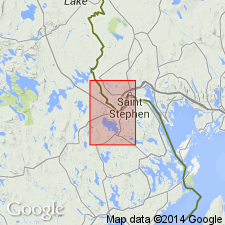
- Usage in publication:
-
- Woodland Formation
- Modifications:
-
- First used
- Dominant lithology:
-
- Metasandstone
- Slate
- Phyllite
- Graywacke
- AAPG geologic province:
-
- New England province
Summary:
Woodland Formation is here [informally] named and assigned as one of four subdivisions to the newly named [informal] Wapsaconhagan Brook Group. This unit composes most of the St. Croix Cambro-Ordovician Belt in the Calais quad. and is well exposed throughout. Previously mapped as an informal member of the Cookson Formation (Ludman, 1985), which is here stratigraphically restricted in eastern ME. Consists almost entirely of rhythmically interbedded quartzofeldspathic wacke and pelite, with both carbonaceous and noncarbonaceous slate or phyllite occurring in most outcrops. Thickness is estimated at over 1000 m. Overlies Kendall Mountain Formation (new [informal] name) and underlies Cookson Formation, both of Wapsaconhagan Brook Group. Intruded by Woodland dump gabbro, Baring granite, Staples Mountain complex, and St. Stephen gabbro. Though most of the Wapsaconhagan Brook may be correlated with rocks of the St. John Group of New Brunswick, there does not seem to be a match for the Woodland. Age is inferred to be Cambrian based on stratigraphic position below the dated Cookson (earliest Ordovician).
Source: GNU records (USGS DDS-6; Reston GNULEX).
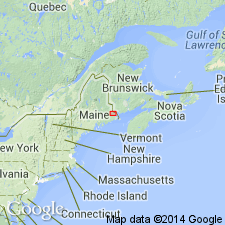
- Usage in publication:
-
- Woodland Formation
- Modifications:
-
- Named
- Dominant lithology:
-
- Sandstone
- Slate
- Pelite
- AAPG geologic province:
-
- New England province
Summary:
Woodland Formation is here formally named and assigned to the Cookson Group (rank raised) in southeastern ME. It is areally the most extensive unit in the St. Croix Belt in ME. In contrast to the other Cookson units, the Woodland contains nearly equal amounts of sandstone and pelite, rhythmically bedded in well-graded sets. Most of the pelite is sulfidic and slightly to highly carbonaceous, but a few gray, noncarbonaceous slates are also present. Overlies Kendall Mountain Formation (new name) and underlies Calais Formation (new name), both of Cookson Group. Approximate thickness of the Woodland is 800 m. Age is inferred to be Late Cambrian based on stratigraphic position below the Calais, which has been dated as Early Ordovician.
Source: GNU records (USGS DDS-6; Reston GNULEX).
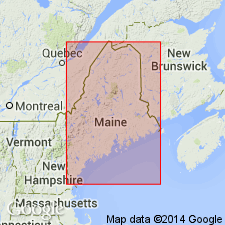
- Usage in publication:
-
- Woodland Formation
- Modifications:
-
- Revised
- Age modified
- AAPG geologic province:
-
- New England province
Summary:
Stratigraphic order of the formations within the Cookson Group is here revised based on new fossil evidence. Ascending, these units are Calais, Woodland, Pocomoonshine Lake, and Kendall Mountain Formations. The Digdeguash, previously considered Silurian, is here included in the Cookson as an equivalent of the Woodland and Pocomoonshine Lake Formations. Kendall Mountain, once thought to be Cambrian and placed at the base of the Cookson, contains Caradocian graptolites and is now considered the youngest preserved part of the Group. Calais Formation, at the base of the Cookson, has been dated as Arenigian. Woodland, once inferred to be Late Cambrian, now believed to be Ordovician based on its conformable contact with the overlying Kendall Mountain. Therefore, Cookson ranges from Early to Middle [Late] Ordovician.
Source: GNU records (USGS DDS-6; Reston GNULEX).
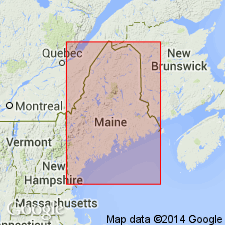
- Usage in publication:
-
- Woodland Formation
- Modifications:
-
- Overview
- AAPG geologic province:
-
- New England province
Summary:
Author disagrees, in part, with revisions of Cookson proposed by Fyffe and Riva (1990). Though he agrees that fossil evidence requires inversion of the stratigraphic sequence, he states that the Pocomoonshine Lake and Digdeguash formations are more likely a part of the Fredericton belt rather than of the St. Croix terrane and therefore are not part of the Cookson Group. Interpretation is based on lithologic and structural evidence. As here revised the Late Cambrian(?) to Middle Ordovician Cookson comprises (ascending) Calais, Woodland, and Kendall Mountain Formations. Author states there is no evidence for the correlation of the Digdeguash and Woodland Formations proposed by Fyffe and Riva (1990). Cookson Group tectonically underlies Pocomoonshine Lake Formation, which conformably underlies Digdeguash. Digdeguash is here assigned a Silurian age and underlies Silurian and Devonian Flume Ridge Formation.
Source: GNU records (USGS DDS-6; Reston GNULEX).
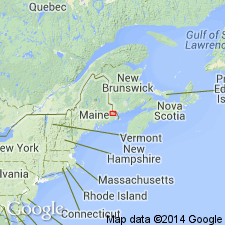
- Usage in publication:
-
- Woodland Formation
- Modifications:
-
- Age modified
- Overview
- AAPG geologic province:
-
- New England province
Summary:
Pocomoonshine Gabbro-Diorite intrudes the Pocomoonshine Lake, Digdeguash, and Flume Ridge Formations in the Fredericton belt and cuts the Kendall Mountain and Woodland Formations of the Cookson Group in the St. Croix belt. The pluton was emplaced during two separate episodes during the Silurian Period. 40Ar/39Ar hornblende ages form the northern mafic portion indicate crystallization at 422.7+/-3.0 Ma. Muscovite plateau age of 414.2+/-3.2 Ma is minimum age for central and southern dioritic portions of the pluton. Therefore, deposition of the Pocomoonshine Lake, Digdeguash, and Flume Ridge Formations is constrained to Late Caradocian (early Late Ordovician) through Early Silurian. The Cookson Group is interpreted as Late Cambrian(?) through Late Ordovician. Age of Woodland Formation, middle unit of Cookson, is Early and Middle Ordovician. According to authors, a major episode of folding and regional metamorphism must have taken place during the Silurian. Melding of the Fredericton, St. Croix, and Coastal Volcanic belts into a single block must have occurred by the Silurian. Accretion of this composite block to ancestral North America, then, was probably responsible for the Acadian Orogeny in northern New England.
Source: GNU records (USGS DDS-6; Reston GNULEX).
For more information, please contact Nancy Stamm, Geologic Names Committee Secretary.
Asterisk (*) indicates published by U.S. Geological Survey authors.
"No current usage" (†) implies that a name has been abandoned or has fallen into disuse. Former usage and, if known, replacement name given in parentheses ( ).
Slash (/) indicates name conflicts with nomenclatural guidelines (CSN, 1933; ACSN, 1961, 1970; NACSN, 1983, 2005, 2021). May be explained within brackets ([ ]).

